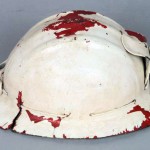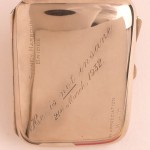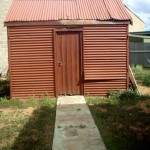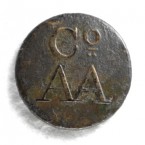White painted Bakelite hard hat, Snowy Mountains Authority, Australia, c 1953-1954. Standard issue protective clothing for use on the Snowy Mountains Hydro-electric scheme. Continue reading
Objects Through Time: economics
Engraved gold cigarette case presented to Major F. E. De Groot, 1932 Inscribed with the caption He is not insane. 21st March 1932. In appreciation W.J.H… Continue reading
Former mosque relocated from the Afghan Camp and later the cemetery in Broken Hill. Continue reading
The piano is historically significant as evidence of piano manufacturing in Australia prior to the World War I through to 1936, as it is possibly one of the last upright pianos, made by Carl von Heiden in his Sydney factory between 1904 and 1914. Continue reading
The textiles machines are of historic significance as evidence of the transfer of haberdashery and tailoring of clothing from the Italian village to Fairfield in the Australia suburbs. Continue reading
The pincers are historically significant as they were made by Carl Konemann. The Konemanns’ are regarded as one of the early pioneering families in Fairfield, providing the essential services of horse shoeing, tool making and repairs and coach building. Continue reading
The bank note has historical value as evidence of the 1988 Bicentennial celebrations and the recognition of the cultural diversity that had evolved in the Australian community up to that time. Continue reading
The butter churn and pat have historic and technological significance as they demonstrate the labour intensive nature of early dairying and butter making and the impact that technological developments such as the cream separator and butter churn and improvements in rail and road transport had on the industry. Continue reading
The cake maker has historical value as evidence of the economic transformation that swept over the suburbs of Sydney in the late nineteenth and early twentieth century. Continue reading
This cane stripper has historical and technological significance in that it demonstrates the the hard manual labour involved in planting, cutting and loading sugar cane before mechanisation of the sugar industry, first of planting and loading sugar cane and later of harvesting the crop.
Continue reading
The cape has historical significance as evidence of the experience of women in middle class families in the nineteenth century and of colonial millinery and clothing retail practices. Continue reading
The Cash register has historic significance as it represents the continuing role of Chinese families in retailing in country New South Wales, well into the second half of the twentieth century. Continue reading
The bell is historically significant as evidence of the changing agricultural practices in the Liverpool area after 1850. Continue reading
The cane knife is historically significant as evidence of the manual labour of the many South Sea Islanders, Indians and migrants from Europe who were the backbone of the sugar industry in northern NSW. Continue reading
The milk jug is historically significant becasue of its association with the Greek owned Civic Café in Murwillumbah Continue reading
Discover Ned Kelly’s Jerilderie letter of 1879 that passionately articulates his pleas of innocence and desire for justice for both his family and the poor Irish selectors of Victoria’s north-east. The Jerilderie letter brings Ned Kelly’s distinctive voice to life, and offers readers a unique insight into the man behind the legend. Continue reading
Discover the Wing Hing Long & Co store collection. The collection is significant because of its association with a NSW rural general store, Chinese migration and the Immigration Restriction Act of 1901. Continue reading
Discover the Convict Cap dated 1850, two years before convict transportation ended on the east coast of Australia. Continue reading
Discover the long sleeved woollen convict jacket made of ‘Parramatta cloth’, c.1855. Continue reading
Discover the brass button from the work clothes of a convict assigned to the Australian Agricultural Company at Newcastle in the 1830s. Continue reading





